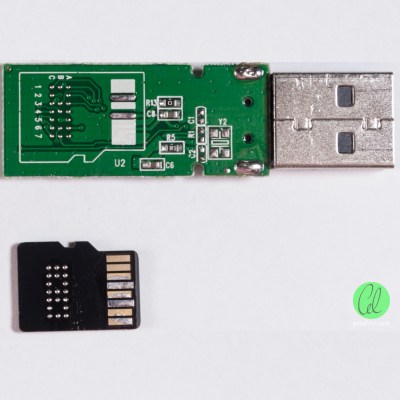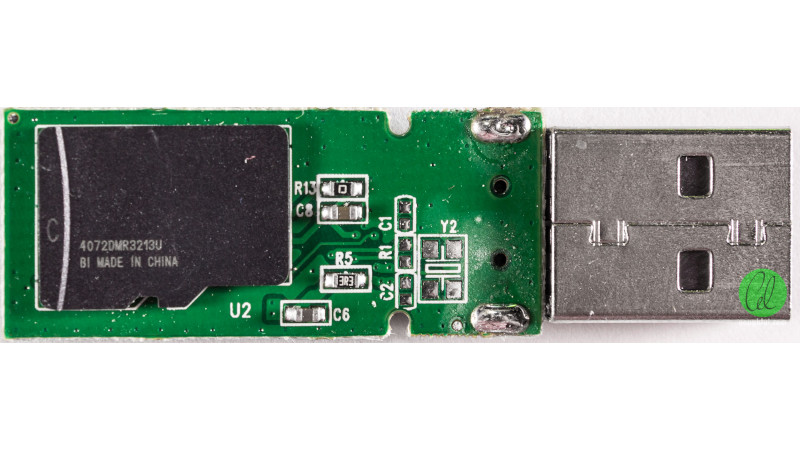Many a hacker has dug an old flash drive out of the bottom of a backpack, and peeled apart the damaged plastic case to look inside. More often then not, you’d expect to see some SMD chips on a PCB along with a few passives, an LED and a USB port. [Gough] found something else entirely, and documented it for the interested public.
 Inside the Comsol 8GB USB stick, [Gough] found an entire microSD card. One might be led to think this is a card reader and microSD masquerading as a normal flash drive, but the reality is far different. Instead, the drive contains a Flash memory controller which addresses the microSD card as raw NAND, through test points normally covered up on consumer-grade cards. The drive appears to be manufactured from factory second microSD cards that don’t pass the normal tests to be onsold to the public.
Inside the Comsol 8GB USB stick, [Gough] found an entire microSD card. One might be led to think this is a card reader and microSD masquerading as a normal flash drive, but the reality is far different. Instead, the drive contains a Flash memory controller which addresses the microSD card as raw NAND, through test points normally covered up on consumer-grade cards. The drive appears to be manufactured from factory second microSD cards that don’t pass the normal tests to be onsold to the public.
Armed with software obtained through spurious channels, [Gough] is able to dive deeper into the guts of the flash drive. The engineering tools allow the card to be optimised for capacity or speed, and different levels of error correction. It’s even possible to have the flash drive emulate a U3 CD ROM drive for OS installs and other purposes.
It’s a great dive into how USB drives work on a low level, and how the firmware and hardware work together. We’ve seen other flash drive hacks before too – like this simple recovery trick!
















your forgetting the part that we now know we can use micro sd cards like smd. which is cool
that’s been known for a fair bit of time https://hackaday.com/2015/08/18/reflow-solder-your-micro-sd-to-ensure-it-doesnt-go-anywhere/
Known for a while yes, but never seen in a commercial product, this is the proof I was looking for!
In the linked article a commenter says he has pulled apart flash drives soldered exactly like this back in 2015.
I think I heard about it that long ago also.
I’ve opened up wifi routers and found a pcmcia slot and a wifi card plugged in. There must be a good reason, thiugh I’m not sure what. You can’t remove the card unless you open the box.
I’ve seen it with 3G cards as well. I guess it’s because they bang a certified module in and don’t need full certification or something.
We did it in a prototype run for a commercial product before switching to eMMC. Some SD cards melt but most work perfectly fine when reflowed.
Melting things makes me want to know how you were soldering these commercial grade products…
prob will melt less often when covered in Kapton tape
It was just the brand of cards. Some had plastic that would melt at a very low temperature (~180C) They still worked but this we didn’t risk. Others could go through a normal reflow process.
It’s very cool as a hack or experiment, but I hope it doesn’t show up too often in real projects. Swappability is awesome!
I found a memory card inside an SanDisk pendrive too I’m having a confusion whether or not to use it.
“normal tests to be onsold to the public.”
onsold?
onsell: Verb
(third-person singular simple present onsells, present participle onselling, simple past and past participle onsold)
(UK, business) To sell something which has been purchased to a second buyer
Origin: on + sell
https://www.yourdictionary.com/onsell#:~:text=onsell-,onsell,purchased%20to%20a%20second%20buyer
Someone manufacturers them, then sells based on test results to companies who brand them and resell. The same thing happens with things like batteries. Dollar store batteries are “Duracells” that didn’t make the grade. Instead of tossing them, they are branded with a lesser name and price point.
Dames goes for monitors, graphics cards, even CPUs.
I love dames!
Really folks, who doesn’t?
That was the best typo. I’m laughing too.
At first glance I thought it was a typo of “sold on”, then I suspected that it might actually be a word. When I saw your message, I decided to look it up, and sure enough it’s actually a real word. Maybe it’s more common in British English than in American English.
Words generally are.
You know — carried on, in a transactional fashion.
In this case being diverted from the intended transaction.
Regional or age influenced colloquialism, perhaps?
Words.
I have a Verbatim flash drive that’s very tiny, with a 4 gig micro SD inserted between the metal plug shell and a thin plate with the data and power contacts.
I was able to pull the card out with a knife then carefully used a Dremel to carve a divot into the metal to make it easier to swap cards. Dunno what the maximum capacity of the device is. Can’t be fast because it’s USB 2.
After buying it I found similar devices being sold on Amazon, minus card and with the divot already in the metal. I wonder if there’s a USB 3 version?
I have a couple of those adapters, and they’re awesome. They’re much more convenient for microSD cards than the slot in the side of my laptop.
Because of those adapters I had assumed that SD cards are directly USB compatible It’s hard to believe they could fit card reader electronics, along with contacts for the SD card and the USB connector, in so tiny a device.
While USB compatibility isn’t part of the SD standard any SD card contains a fairly powerful (at least by my old school standards) computer to do the wear leveling and protocol translation. Even though the SPI interface that makes SD cards so convenient for embedded stuff isn’t part of the uSD standard, nobody seems to have ever found a uSD card that doesn’t implement it probably because it doesn’t make sense to make different controller chips for SD and uSD. I would be unsurprised to find that the SD controllers which are after all 100 MHz computers with who knows what peripherals on the silicon couldn’t also do USB, and again why have a different controller?
one of my favorite thumb drives was a maxwell branded one that had a sd card slot also, it will show up as a 4 gig flash drive as well as the sd card contents, made it nice to carry portable apps on the drive and not need a separate sd reader, I look occasionally but havent found any similar products.
This is how some Chinese manufacturers and system builders and recyclers make money for a long time.
His site suddenly went 404 right in the middle of loading it. :P
Maybe it was hosted on a “factory second microSD card” ;-)
“software obtained through spurious channels”
This seems like a spurious use of an adjective. Did you mean dubious?
Maybe they were pretending to be channels.
Great Apocryphal Channels Batman!!
“Tune in tomorrow! Same Bat-time, same Bat-channel!”
I thought this was common knowlege? im far from a tech geek, but have smashed up a few usb thumb drives in my time, and they often have sd cars with those extra pins exposed. Did always wonder what they were. now i know :)
Glad for the short article… I never knew this (not common knowledge to me). I always thought there would be just a memory chip or two onboard with a controller circuit under the plastic …. not an SD card being used as the memory chip(s). I guess that is one way to cut costs? Next time one of my thumb drives go bad, I’ll check it out… rather than just take a pliers to it to make totally unusable….
Actually, that’s not the same thing.
Plenty of people have soldered to the normal slot pins like that.
This flash drive uses the BGA which is normally covered by the silkscreeen/epoxy
Given the absurd price of NAND flash chips from the big online component suppliers (why is that!?), this is a potentially interesting solution for lowish volume products.
Microcenter Inland 256GB USB thumb drive survived front load washing machine.
Plastic casing is starting to separate.
Device still functions properly.
Cool mounting technique.
But, if they’re not good enough to be sold as SD card, how are they good enough for this?
Sounds like those old “256GB” sticks that only had 8GB and just looped the same 8GB all over the addressing space.
I bought one of those cheap flash drives at a dollar store out of curiosity. I think I tried reformatting it immediately under Linux. I couldn’t figure out what was happening. I can’t remember, but maybe it was just repeating. I was never able to get it to work with Linux.
One reason I bought it was because it was cheap, and sometimes small is what’s needed. I can get much larger flashdrives for what I paid for my first 1gig, but sometimes Ijust need 1gig.
I would imagine the issue is with the flash controller on the SD card. Either that or bad blocks of flash memory that are programmed out on the USB stick controller to make it have less capacity than manufactured for (maybe you can’t do that on the SD controller for some reason, idk).
Maybe also for supply chain reasons? Nand flash shortage but a glut of SD cards…